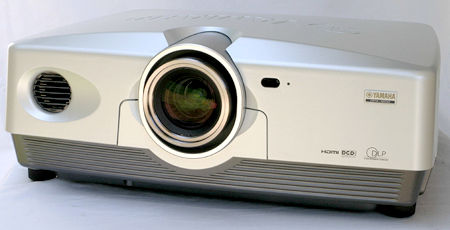Yamaha DPX-1200 DLP projector

The DPX-1200 is Yamaha's fourth-generation DLP projector, two generations removed from the last one we reviewed. It includes virtually the same feature set as the DPX-1100, which we did not evaluate. The only difference I could spot from a study of Yamaha's own literature is the presence of TI's DarkChip3-equipped 1280x720 HD2+ DMD in the new design. Yamaha claims that this new widescreen chip delivers 25% higher contrast than previous versions.
TI wants to reinvent the designations they use for their Digital Micromirror Devices (DMDs). They plan to drop the "HD" nomenclature we're all accustomed to and move to a simpler 720p/1080p designation with DarkChipX enhancements (DarkChip2, DarkChip3). But this certainly adds confusion to the "which chip is up" question during the transition period.
In any event, I had no real complaints about the way the new Yamaha performed on most deep blacks and shadow details. And that's only one of the reasons the DPX-1200 should be at or near the top of your shopping list if you're in the market. With its new DMD, flexible iris options, and other features, this projector has definitely made a big splash here at UAV.
Useful Features
At over 30 pounds, the Yamaha is one of the heaviest 1-chip DLP projectors I've reviewed. Heavy lifting aside, however, it's no more difficult to set up than the competition. There are three built-in test patterns (crosshatch, reverse grayscale ramp, and color bars), but I generally ignored them in favor of externally generated patterns. Motor-driven V.Pos (vertical lens shift), Focus, and Zoom (1.6x) controls make fitting the image to the screen fast and easy.
The seven-segment color wheel adds a neutral-density filter to its dark-green segment. According to Yamaha, this improves color reproduction and detail in darker scenes, and produces a sharper, more accurate picture. Of course, it also reduces image brightness. But the Yamaha is a comfortably bright projector nonetheless, as long as you don't go overboard on screen size.
The DPX-1200 has all the inputs you're likely to need (including a D4 component connection that's popular primarily in the Japanese market). Its single HDMI input is a limitation we've seen on all projectors to date without external switch boxes
The controls on the top rear of the projector are less likely to see heavy use than those on the wireless remote control (which may also be hard-wired to the unit). The remote is identical to the one furnished with previous Yamaha DLPs. It's easy to handle and has well-positioned buttons. Even the Reset button—a dubious feature on any remote—is unlikely to be pushed accidentally. Only six of these buttons are illuminated, but they're the ones you're most likely to need in the dark.
Six aspect ratios are available on the DPX-1200, including the usual Normal, Squeeze (anamorphic), Zoom (letterbox) and Smart Zoom, an uneven stretch for filling the 16:9 screen with 4:3 program material. The latter wasn't very smart at all; it produced obvious image distortion. There's also an Auto setting, which occasionally chooses the right aspect ratio. Like similar modes on other video displays, Auto relies on digital codes, or flags, in the source to tell it what to do, and those flags are not always there.
You also get a few Special aspect ratio settings I never used. To eliminate the black bars in a 2.35:1 image by blowing it up and then cropping it to fit a 16:9 screen (eech!), you get both Cinema Squeeze (for conventional letterbox widescreen) and Cinema Zoom (for anamorphic widescreen). There are also two Through modes that display an image in its native pixel resolution without aspect-ratio processing or scaling—a handy feature for use with an external scaler.
Typical of most projectors, not all of these aspect ratios function with all possible inputs. With 480i or 480p analog or digital (HDMI) video sources, they are all accessible. At 720p or 1080i, however, only Normal and Cinema Zoom are available. And neither of these would display a 4:3 or conventional letterbox (non-anamorphic) widescreen image from a Pioneer DV-59AVi DVD player without distortion. In the latter case, selecting 480p or 480i from the player restored restore full aspect ratio control.
The control menus can be set up in two different modes: Standard or Advanced. All of the following descriptions relate to the Advanced mode, which can be accessed by the user without a special entry code. The controls described below were fully functional with either an analog or digital (HDMI) video input at all of the most frequently used input resolutions I tried: 480i, 480p, 720p, and 1080i.
The usual video adjustments are provided. Refreshingly, Yamaha refers to the usual Brightness and Contrast controls by their more accurate designations—Black Level and White Level—for conventional video sources,. (They still call them Brightness and Contrast with RGB computer inputs).
There are 10 different Gamma settings, rather confusingly labeled A, a, B, b, C, c, D, d, E, and e. The capital-letter settings are said to simulate the gamma of a CRT display. I preferred the D gamma overall, and all of my tests and observations were made at this setting.
There are two sharpness controls: Sharpness Type (five settings, including Off) and Sharpness Gain (0 to 10). Setting the Sharpness Type to Off defeats both controls. For most material, I preferred Sharpness Type on Low and a Sharpness Gain of 2.
The Black Level and White Level adjustments naturally control the peak white and minimum black levels, but there is really only one correct setting for each of them. Yamaha also includes three adjustments that provide additional control over the projector's brightest whites and deepest blacks. The first is a 3-position iris. Fully open is the torch mode, making full use of the projector's 270W lamp but sacrificing black level in the process. It's okay for non-critical use with some ambient room lighting, but I'd never select it for serious movie watching unless I had a really big screen.























































